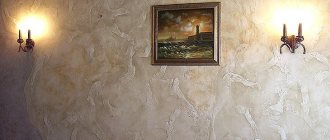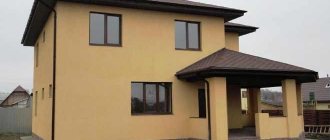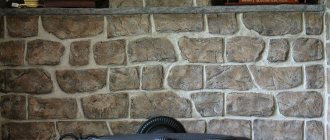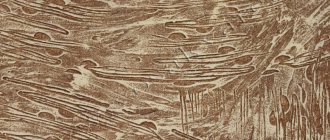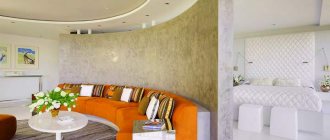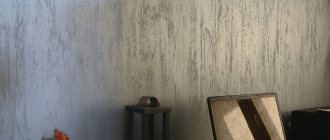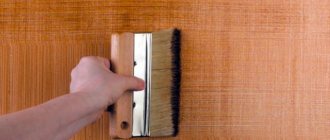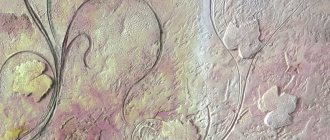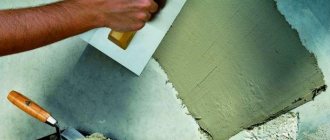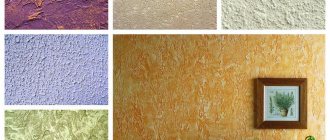One of the popular finishes is fur coat plaster. Despite the fact that of the currently existing decorative plasters, Venetian plaster claims the laurels of primacy most of all, and, at first, as a smooth coating on which various images were applied. For facades, relief plasters such as fur coat and bark beetle are still more often used. And these are decorative textures.
No one can say exactly when and where the first plaster appeared. Apparently, each region of the world invented its own plaster. It is known that the first mortar for plastering was clay. As for the desire to decorate the space around oneself, it was inherent in Stone Age man, when the first decorated surfaces of rooms were the painted walls of caves.
Having invented plaster, a person simply could not leave it without decoration. And so it happened. For a craftsman, it is not enough to build a house himself; he certainly needs to protect and decorate it with his own hands.
The composition of the mixture, its pros and cons
Decorative plaster fur coat is distinguished by a surface texture that is similar to a slightly crushed sheepskin turned inside out. It is performed in different ways from compositions on the already familiar acrylic, mineral and silicone bases.
Mineral
The oldest are mineral compositions, which, in addition to binders of lime and cement, include sand as a filler. To improve the solution, substances are added to the mixture that give it plasticity, fire resistance, resistance to rotting, resistance to UV rays and other properties. Manufacturers often replace river sand with quartz. The dry mixture is sold in bags.
Fur coats made from mineral mixtures are environmentally friendly, non-flammable, cheapest, and frost-resistant. A significant drawback is its susceptibility to cracking even at the slightest linear deformation of the base and during vibrations. Therefore, finishing with mineral binders is called hard.
Acrylic
Another composition base is acrylic. Coat plaster made from synthetic acrylic resins is elastic. Therefore, unlike mineral plaster, acrylic plaster can be used in areas where seismic activity is high and near railway tracks. The choice of ready-made acrylic compositions is very wide. In terms of structure, these can be fine-grained for indoor use, and coarse-grained for outdoor work.
To prevent fungi from harming the walls and mold from appearing, bactericidal additives are added to the composition. Additives are also added to make it resistant to ultraviolet rays. Acrylic polymers are flammable substances. Although the composition contains fire retardants, acrylic finishes are not placed near fire sources. Acrylic compounds cost more than mineral ones, but significantly less than silicone ones.
Silicone
This type does not have the disadvantages of the above-mentioned compositions. The binders in it are polymer resins. The most resilient and durable finish. However, a significant drawback is the high price. Therefore, as a rule, silicone plaster is not used for finishing large surfaces - for facades.
The silicone mixture dries a little longer than others, so take this feature into account when using it.
Textured plaster fur coat has such advantages as:
- good tolerance to serious temperature changes,
- resistance to environmental pollution and precipitation,
- hiding small flaws in the base,
- rich palette,
- good vapor permeability,
- ease of implementation,
- low specific gravity of the coating,
- high thermal insulation qualities,
- low noise permeability,
- seamless coating,
- easy DIY installation,
- easy repairs,
- remarkable longevity.
Disadvantages include the ability to attract and accumulate dust. Therefore, such coatings have to be washed more often than smooth or less textured ones.
Description
Decorative plaster Prospectors “SHUBA” is made on the basis of a composition of white cement and dolomite chips using polymer and modifying additives.
Fraction 3 mm. Designed for application on surfaces as a decorative layer for interior and exterior decoration. It is used for interior work (normal humidity and high humidity) and exterior facade work for subsequent painting. Apply manually to the following types of substrates: concrete/reinforced concrete, cement plaster, gypsum plaster, plasterboard.
Where and what is it used for?
This type of finish is universal. It is used in the interiors of large premises. It is more widely found in the design of the exterior of buildings. Such decorative plaster of the facade is even more widespread than the well-known marble plaster. Taking into account the difference in working conditions, the compositions are produced for internal or external use, universal. To increase the ability to resist the influence of environmental factors, appropriate additives are used in the formulations.
The surface texture is obtained due to two factors: the structure of the composition (the main role is played by the size of the grains) and the relief laying (the main role is played by the method of application). Textures with a more pronounced relief are used mainly for facades. Decorative plaster with a fur coat effect for finishing the facade of a house can be made from pebble compositions and has additives that increase resistance to UV rays, frost resistance, etc.
Indoor conditions are milder. However, limited space imposes its own conditions. Pronounced reliefs conceal space and visually burden the room. Therefore, decorative plaster for interior wall decoration with a fur coat effect is usually fine-grained. Of the application methods, those that give a smoother relief are selected.
Features of painting when finishing with fur coats
The needle-like, uneven texture of the resulting coating creates difficulties when painting it. First of all, this is an increased surface, which leads to excess paint consumption; at the same time, it is impossible to use brushes and rollers, because this leads to overuse of paint or poor quality of painting.
Good quality painting is achieved when using a spray gun. The spray gun turns the paint into dust-like drops that cover uneven surfaces, reducing paint consumption. Noticed unevenness in coloring can be corrected with a brush. Before applying paint, it is recommended to clean the surface and treat it with a primer for better adhesion to the surface covered with plaster.
Main and auxiliary tools
There are two methods by which the solution is applied:
- manual (several ways),
- mechanized.
Each of the existing methods is performed with the appropriate tools.
The simplest (technically) method is application with a broom. The main tool is a broom. However, not just any broom will do, but one made from thin, fairly rigid twigs. The relief depends on the diameter. The thinner the branches, the shallower the relief. Decorative plaster fur coat, made by applying relief with a roller, is more suitable for interior decoration. The roller can have short or long pile. Typically, a roller is used for fine-grained compounds. The main tool for manual application can also be a trowel or a brush with long, hard bristles, and even a paint brush.
For mechanized application, special devices are used. To process small surfaces, a mechanical machine (“hurdy-gurdy”) is used, which is a body with an opening in which a brush-brush equipped with a rotating handle is attached to the axis. A metal rod is placed in the path of the ends of the bristles, touching which the bristles bend, and then, when released, they “throw” the solution tangentially. For large areas, a cartouche gun and a plastering machine (with a compressor) are used.
Other devices and tools:
- spatulas,
- level,
- containers, brushes, masking tape, clean rags and others.
Fragmentary application of a “fur coat”
For fragmentary application of a fur coat, it is advisable to prepare the appropriate areas
In the event that it is necessary to apply a “coat” to certain sections of the facade, thus drawing geometric shapes, or to highlight wall protrusions, it is recommended to initially make such elements with a mortar for plastering. As a rule, in such cases the pedestal is not made, and textured plaster is applied to designated areas, previously limited by slats .
Considering that the surface of the “coat” has a rough texture, the rough plaster does not need to be rubbed with a construction trowel. The only exception is deep corrosion. They should be removed when leveling the walls as a rule.
Preparing the walls
Since fur coat plaster is a relief finish without seams, it does not require correction of minor defects in the base. The rest of the preparation is carried out in the same way as for other textured finishes.
Subsequence:
- the wall is inspected, the remains of the previous coating are removed, the wall surface is leveled if necessary,
- Large defects are repaired with a solution of sand and cement 3:1.
- stains are degreased,
- neutralize biological damage,
- large cracks are “healed” using a polymer mesh,
- the surface is primed according to the base material with a primer composition containing quartz sand,
- the prepared base is dried.
Facade plaster with fur coat relief for external use can be applied to sheet insulating material. To do this, the surface of expanded polystyrene or other insulation is covered with a “casing” of a solution (cement-sand 1:3) reinforced with its polymer mesh.
The sequence of installing the mesh on the glue: first, a layer of glue is applied, then the reinforcing mesh, the finishing layer of glue. Applying the mesh to the wall and covering it with glue only on top is NOT ALLOWED.
After it dries, decorative finishing is applied. Read more about how you can make a fur coat on the wall.
How to paint a ceiling without streaks, streaks and unevenness
Painting the ceiling is the most common way to repair it. But it’s far from the easiest: to achieve a good result, you’ll have to spend a lot of time and take into account several subtleties. The topic of our article is how to paint a ceiling without streaks and other defects.
Our goal is the perfect ceiling. Material: water-based paint. Let's find out how to apply it correctly.
Preparing the room will come down to taking out what can be taken out and covering everything else. The ideal material for protecting against paint drops is polyethylene film. But preparing the surface of the ceiling will be much more hassle:
This is interesting: How to install facade panels on a frame house in detail: Step-by-step instructions
Technology and application conditions
You can delegate this “design” work to professional plasterers. Or, guided by the slogan “it’s not the gods who burn the pots,” you can master (perhaps from scratch) coat plaster using any application technique. In principle, all techniques are based on three main methods of applying the solution:
- transferring from a trowel/trowel to the wall with strokes,
- splashes,
- or rolling with a roller.
In the first case, the resulting fairly flat surface is made using a relief tack technique - when, due to its viscosity, behind the trowel applied to the surface and moved away, strings of the solution are drawn, creating fur-like protrusions when broken. In the second case, the pattern is created due to irregularities - lumps of adhering splashes. The third case combines the first two. How to make a fur coat? Fur coat using a roller video
Manual application
- A quick and fairly effective method is spray application with a broom. It probably couldn’t be simpler. A broom is dipped into a bucket of solution, then with a sharp movement the solution is sprayed onto the wall. The thinner the broom twigs, the finer the pattern. You can leave this finishing for the façade. Or you can get a more interesting grated fur coat. To do this, after applying the solution and a short break necessary for drying, the tops of the protrusions are slightly smoothed with a wet trowel or spatula. When processing a large area, as it dries, the pressure is gradually increased so that the smoothing is uniform.
- Application with a roller is even easier. The pattern can be applied using a roller in two ways. You can simply dip the roller in the solution and “paint” the wall right away, or you can “paint” the surface of a fresh layer that has already been laid with a spatula or trowel. After waiting until the solution has set, the sharp protrusions are slightly smoothed with a trowel or spatula.
- By applying and tearing off the “sticky” trowel, the newly laid layer is given a “hairiness”. If desired, it can also be smoothed with a wet tool after drying.
- Special mixtures are applied to the wall with a trowel and then, after drying for 5-10 minutes, rubbed in a circular motion. There is no need to do any other actions with special mixtures. This method is reminiscent of applying a coating of bark beetles.
Mechanized application
Plastering under a fur coat using mechanical technology is easier and faster than applying a fur coat to the wall with your own hands. A device for mechanically applying a solution is similar in design to a spray gun. The solution is placed in the receiving funnel, falls under its own weight to the lower part and enters the nozzle, from where it is sprayed onto the wall by the force of the air jet. For mortars on cement and sand, you need to apply the coating two to three times. For other solutions – 1-2.
Staining and tinting
Fur coat plaster requires painting, since it itself has a white or grayish color. You can paint the finish after it has dried or add pigments to the composition at the mixing stage. Tinting gives a more reliable, aesthetic result, although it requires more thorough mixing of the mixture.
The easiest way is to add some paint to the plaster. Dry pigments are also suitable - powdered coal, manganese, red iron ore, cobalt glass. After applying the plaster, you do not have to paint it, and the color of the pigment will remain for a long time. There are few downsides to this technique. You will have to carefully measure the amount of dye, otherwise different portions will look different.
Painting an already dry surface is quite a labor-intensive task, because its texture is rough, with bulges and pits, and therefore does not paint well. It is best to carry out all manipulations using a spray gun; in extreme cases, use a fleecy roller. Painting with a brush is not a very rational solution and will require a lot of time and effort. The technique has other disadvantages:
- Only the surface layer of plaster is painted, so the durability of the coating is reduced;
- if cracks appear on the plaster layer, they will be unsightly, and the lack of paint inside will only emphasize the defect;
- If the plaster is gray in color, painting it in light shades is problematic; painting it in bright, saturated colors is only possible.
Coloring
Mixtures available for sale may be uncolored, white or gray. They can be colored before use by adding selected dyes. Already painted mixtures are also sold. The choice of colors is quite rich.
If coloring the solution is done before use, then two things should be taken into account:
- the brightness and tone of the freshly applied mass fade as it dries (when selecting a shade, it is better to do a test paint),
- when working on large areas, you need a lot of mortar; with manual tinting it is difficult to achieve the same color for different batches of mortar (the solution is painting the finished surface).
Do-it-yourself fur coat plaster is a little more difficult to paint than a smooth coating, because you need the paint to get into the numerous dimples. This is easier to do with shallow relief and a small area of the area to be painted. Sometimes in the interior, on the main smooth background of the wall with a fur coat, accent shaped areas are made that require different colors. In this case, you can use a brush. However, in all other cases it is more rational to use a spray gun. A detailed description of the coloring of different types of decorative mixtures.
Painting the plaster surface under a fur coat
Some plasters are sold already painted, for example, Diamant Knauf dry mixes, but if you want to add your own creativity, then painting the “fur coat” surface is not difficult. The main thing here is to follow certain principles. The fact is that it is difficult to paint such a relief on the wall with a brush. The surface is not uniform, and to achieve complete staining, you will have to repeat the process several times. This situation will increase the cost of finishing several times, and it will no longer be possible to talk about a cheap facade. On the other hand, applying special facade paints in several layers will further protect the facade from external negative influences. The choice is yours.
The easiest and most economical method to get a colored fur coat is to use a spray gun. Using a mechanical method, you will not only evenly distribute the paint over the surface of the textured plaster, but also save on material. There is no need to exclude working time - with a spray gun, painting will be several times faster and easier.
Painting with a spray gun
Popular manufacturers
Most manufacturers of decorative plaster have in their product lines mixtures suitable for making fur coat finishes for all conditions of use (house outside and inside). The most popular are Ceresit (Henkel concern), Knauf, Osnovit, Weber Vetonit .
- Ceresit Dekor Plus tolerates Russian weather conditions well, has good characteristics and a fairly affordable price. The fur coat is obtained using a short-pile roller. Decorative plaster coat has a calculated consumption per 1 m2: fine-grained - 1.8 kg, medium-grained - 2 kg, grain from 2.5 mm - 3.5 kg.
- Weber Vetonit produces dry mixtures. The line also includes compositions for fur coats. A universal cement-lime dry mixture with 2 mm marble aggregate is characterized by increased water and frost resistance. It hardens without shrinkage. Can be used in bathrooms. The finished coating is painted with water-dispersed paints. Consumption from 1.2 to 2.4 kg/m2 of dry mixture.
- Bergauf Diadema also produces high-quality decorative products. Bergauf fur coat facade plaster is affordable in price and is famous for its good technical characteristics. You can buy ready-made mixtures.
- Lakra plaster with a fur coat effect is produced using German technologies . The water-acrylic dispersion can be applied with a roller. Consumption 1-1.5 kg/m2. The disadvantage of the mixture is its short pot life - 20 minutes.
- Knauf produces a mineral structural mixture called Diamant, with synthetic grains of various colors and shapes, suitable for this type of finish. Can be applied manually or mechanically. Consumption 3.8.kg per 1m2. The line also includes a cement-polymer dry mixture with a grain size of 1.5 mm. It is easy to install and economical in consumption. Resistant to vibration, atmospheric and mechanical influences.
The popular fur coat plaster is a decorative coating that is excellent in its performance and aesthetic characteristics. The choice of dry mixtures and solutions ready for use is wide. In almost all cases, it makes it possible to select the coating that is most suitable in terms of quality and price. Easy implementation is another reason to take a closer look at this type of finish.
Purpose
Mineral structural plaster Prospector “Shuba” is intended for application to surfaces as a decorative layer for interior and exterior decoration.
Recommended as a finishing decorative layer in facade thermal insulation systems with external plaster layers. Suitable for smooth bases made of concrete, cement, cement-lime, gypsum plasters, gypsum plasterboard, gypsum board sheets, etc. Not intended for the basement of building facades. Forms a thin-layer coating with a rough-grained structure of the finished surface for subsequent painting with facade water-dispersion paints.
Tips for making a fur coat
The method of applying a fur coat finish is quite simple, but there are some features of its application. By adhering to these rules, you can obtain a strong and durable coating that reliably protects the facade of the house from external factors. Here are some secrets of using the method:
- It is recommended to carry out work at air temperatures from +5 C to +27 C. The surface must be protected from direct rays of the sun. Cloudy, not rainy weather is optimal.
- Each layer must be done at one time, after applying the layer it must dry.
- The surface on which the plaster is applied must be carefully treated with a primer.
- It is not recommended to use thick solutions. The consistency of the finished solutions must be such that the plaster holds and does not flow down the surface.
- To preserve the color of the coating for a long time, it is recommended to use natural dyes: red iron ore, manganese, asbestos, powdered marble and cobalt glass, crushed coal.
- The best quality coating is obtained by using a broom and a stick or mesh.
Finishing building surfaces with a fur coat is one of the ways to update the appearance of old buildings and create an individual look for new buildings. The method is simple and accessible for beginners to master. A variety of colors and texture additives allows you to give a unique look to buildings. The cost of finishing is low and has a long service life. Finishing buildings with a fur coat will not require maintenance costs.
Paint Spray gun Finishing Painting wall facade Plaster
Material characteristics
There are quite a few varieties of such cladding. The composition, grain size, consumption and, consequently, the price of the material differ. Fur coat finishing can be supplied either dry or ready-to-use. Also keep in mind that this composition is suitable for processing both inside and outside the house, for example, the facade.
The solution, depending on the manufacturer, has a different composition. But in almost every Shuba plaster you can find mineral chips and marble particles. During processing, a drop effect is created, but at the same time high strength and reliability of the coating is ensured. Now let's take a closer look at the benefits of using decorative fur coat lining. The process of finishing the facade can be seen in the following photo.
